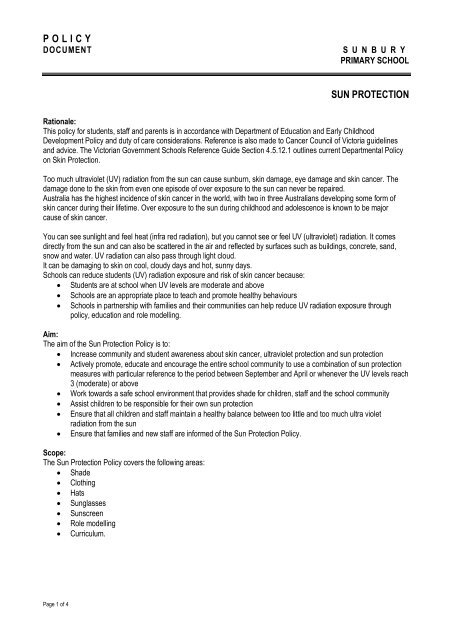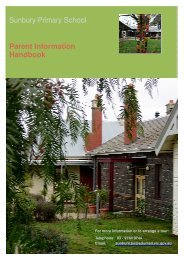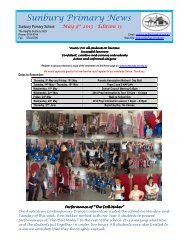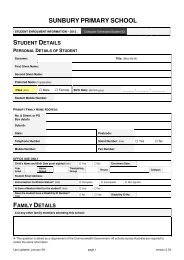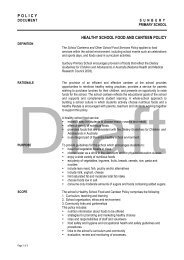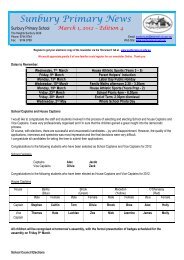POLICY SUN PROTECTION - Sunbury Primary School
POLICY SUN PROTECTION - Sunbury Primary School
POLICY SUN PROTECTION - Sunbury Primary School
You also want an ePaper? Increase the reach of your titles
YUMPU automatically turns print PDFs into web optimized ePapers that Google loves.
P O L I C Y<br />
DOCUMENT<br />
S U N B U R Y<br />
PRIMARY SCHOOL<br />
<strong>SUN</strong> <strong>PROTECTION</strong><br />
Rationale:<br />
This policy for students, staff and parents is in accordance with Department of Education and Early Childhood<br />
Development Policy and duty of care considerations. Reference is also made to Cancer Council of Victoria guidelines<br />
and advice. The Victorian Government <strong>School</strong>s Reference Guide Section 4.5.12.1 outlines current Departmental Policy<br />
on Skin Protection.<br />
Too much ultraviolet (UV) radiation from the sun can cause sunburn, skin damage, eye damage and skin cancer. The<br />
damage done to the skin from even one episode of over exposure to the sun can never be repaired.<br />
Australia has the highest incidence of skin cancer in the world, with two in three Australians developing some form of<br />
skin cancer during their lifetime. Over exposure to the sun during childhood and adolescence is known to be major<br />
cause of skin cancer.<br />
You can see sunlight and feel heat (infra red radiation), but you cannot see or feel UV (ultraviolet) radiation. It comes<br />
directly from the sun and can also be scattered in the air and reflected by surfaces such as buildings, concrete, sand,<br />
snow and water. UV radiation can also pass through light cloud.<br />
It can be damaging to skin on cool, cloudy days and hot, sunny days.<br />
<strong>School</strong>s can reduce students (UV) radiation exposure and risk of skin cancer because:<br />
Students are at school when UV levels are moderate and above<br />
<br />
<br />
<strong>School</strong>s are an appropriate place to teach and promote healthy behaviours<br />
<strong>School</strong>s in partnership with families and their communities can help reduce UV radiation exposure through<br />
policy, education and role modelling.<br />
Aim:<br />
The aim of the Sun Protection Policy is to:<br />
Increase community and student awareness about skin cancer, ultraviolet protection and sun protection<br />
Actively promote, educate and encourage the entire school community to use a combination of sun protection<br />
measures with particular reference to the period between September and April or whenever the UV levels reach<br />
3 (moderate) or above<br />
Work towards a safe school environment that provides shade for children, staff and the school community<br />
Assist children to be responsible for their own sun protection<br />
Ensure that all children and staff maintain a healthy balance between too little and too much ultra violet<br />
radiation from the sun<br />
Ensure that families and new staff are informed of the Sun Protection Policy.<br />
Scope:<br />
The Sun Protection Policy covers the following areas:<br />
Shade<br />
Clothing<br />
Hats<br />
Sunglasses<br />
Sunscreen<br />
Role modelling<br />
Curriculum.<br />
Page 1 of 4
P O L I C Y<br />
DOCUMENT<br />
S U N B U R Y<br />
PRIMARY SCHOOL<br />
Recommendations for practice:<br />
<br />
All students and staff use a combination of sun protection measures throughout the day to ensure they are well<br />
protected. Particular care is taken between 10am and 2pm. (11am and 3pm daylight saving time) when UV<br />
levels reach their peak<br />
Sun protection measures are not used from 1 st September to the 1 st May unless the UV index level reaches 3<br />
and above<br />
<br />
Our Sun Protection policy is considered when planning outdoor events e.g. assemblies, camps, excursions and<br />
sporting events. Where possible outdoor activities or events are conducted earlier in the morning or later in the<br />
afternoon, or indoor venues are utilised. Staff preparing and planning for outdoor events must document<br />
preparation of students for sun protection in the school’s excursion planning document.<br />
Page 2 of 4<br />
1. SHADE:<br />
<br />
<br />
<br />
<br />
2. CLOTHING:<br />
<br />
In consultation with the <strong>School</strong> Council, shade provision is considered in plans for future buildings and<br />
grounds<br />
The availability of shade is considered when planning excursions and outdoor activities<br />
Students are encouraged to use areas of available shade when playing outside<br />
Students who do not have appropriate hats or outdoor clothing are asked to play in a pre-determined<br />
shaded area.<br />
Sun protective clothing is included in the school’s Dress Code Policy. <strong>School</strong> clothing is made of close<br />
weave fabric and includes shirts with collars and longer sleeves, longer style dresses and shorts and rash<br />
vests or t-shirts when swimming.<br />
3. HATS:<br />
Students are required to wear hats that protect the face, neck and ears, i.e. broad brimmed hats (with at<br />
least 8cm brim) or bucket hats, whenever they are outside. Please refer to our Student Dress Code policy.<br />
(Please note: baseball caps do not offer protection and therefore are not SunSmart recommended hats.)<br />
4. <strong>SUN</strong>GLASSES: (not mandatory)<br />
Students and staff are encouraged to wear close fitting wrap around sunglasses that meet Australian<br />
standard 1067 (Sunglasses: Category 2, 3 or 4) and cover as much of the eye area as possible.<br />
5. <strong>SUN</strong>SCREEN:<br />
<br />
<br />
<br />
<br />
SPF 30+ broad spectrum, water resistant sunscreen is available for staff and children’s use. Sunscreen is<br />
applied at least 20 minutes before going outdoors and reapplied every two hours if outside for long periods<br />
of time<br />
Teaching staff remind students to apply sunscreen before going outdoors<br />
First Aid kits are to contain SPF 30+ broad spectrum, water resistant sunscreen which is ideal for low<br />
allergenic sensitive skin types<br />
Students who are allergic to sunscreen are to be identified by parents when they provide medical advice<br />
about their child. Staff are to report to a student’s parent or guardian any adverse reaction to sunscreen.<br />
6. ROLE MODELLING:<br />
Staff are expected to act as role models by -<br />
‣ Wearing school approved broad brimmed hats, appropriate clothing and sunglasses when outside<br />
‣ Applying SPF 30+ broad spectrum, water resistant sunscreen<br />
‣ Seeking shade whenever possible.<br />
<br />
Families and community members are expected to use a combination of sun protection measures (sun<br />
protective clothing and hats, sunglasses and sunscreen) when participating in and attending outdoor<br />
school activities<br />
7. CURRICULUM:<br />
<br />
Programs on skin cancer prevention are included in the curriculum for all year levels and Cancer Council of<br />
Victoria resources are sourced
P O L I C Y<br />
DOCUMENT<br />
S U N B U R Y<br />
PRIMARY SCHOOL<br />
<br />
SunSmart behaviour is regularly reinforced and promoted to the whole school community through<br />
newsletters, parent meetings, staff meeting, school assemblies, student and teacher activities and upon<br />
student enrolment.<br />
Evaluation:<br />
Community feedback is to be encouraged and documented throughout the year by the <strong>School</strong> Council Policy<br />
Committee.<br />
Review:<br />
<strong>School</strong> Council will review the effectiveness of the Sun Protection Policy every three years or revise the policy where<br />
required or as directed by the Department of Education and Early Childhood Development policy, or guidelines or advice<br />
from the Anti-Cancer Council of Victoria.<br />
Review date: 2012.<br />
Policy ratified by <strong>School</strong> Council: Monday, 14 th September 2009.<br />
Relevant Documents/Links:<br />
<br />
<br />
<br />
<br />
Victorian Government <strong>School</strong>s Reference Guide: 4.5.11 Skin protection<br />
www.eduweb.vic.gov.au/referenceguide/envir/default.htm<br />
Anti-Cancer Council of Victoria<br />
www.cancervic.org.au/<br />
Building Quality Standards Handbook (BQSH): Section 7.5.5 Shade Areas<br />
Occupational Health and Safety Act 2004<br />
Sections 21 and 23: Main duties of Employers<br />
Section 25: Duties of Employees<br />
www.worksafe.vic.gov.au > Laws and Regulations > Acts and Regulations<br />
<br />
<br />
Australian Safety and Compensation Council (ASCC): Guidance Note for the Protection of Workers from the<br />
Ultraviolet Radiation in Sunlight<br />
www.ascc.gov.au/assoc/HealthSafety/HazardsSafetyIssues/UltraviletRadiationSunlight.htm<br />
Sun Smart UV Alert (issued) whenever the UV Index reaches 3 and above<br />
www.sunsmart.com.au<br />
UV and Vitamin D:<br />
www.sunsmart.com.au/browse.asp?ContainerID=1917<br />
Page 3 of 4
P O L I C Y<br />
DOCUMENT<br />
S U N B U R Y<br />
PRIMARY SCHOOL<br />
Page 4 of 4


